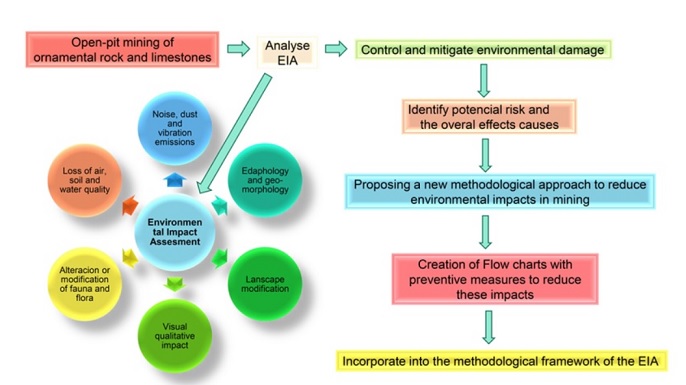Document Type : CASE STUDY
Authors
1 Departamento de Agroquímica y Medio Ambiente. Universidad Miguel Hernández de Elche Edif. Alcudia. Avda. de la Universidad, Alicante, Spain
2 Departamento de Organización Industrial y Electrónica. Escuela Superior de Ingeniería y Tecnología, Universidad Internacional de la Rioja, Madrid, Spain
Abstract
BACKGROUND AND OBJECTIVES: Open-pit mining is an important activity to obtain mineral resources that supply society with raw materials to improve people's quality of life. However, this extractive activity causes negative environmental impacts and, it is therefore necessary to identify and evaluate these impacts in order to design preventive and control measures to reduce them and thus safeguard the environment and natural resources. In the Region of Murcia, in Spain, as well as other Mediterranean areas with similar climatic conditions, there is a great deal of mining activity linked to the building sector, in which mainly ornamental rock (marble and marble limestone) and limestone aggregates are used. All of this has given rise to numerous active and abandoned mines, where no restoration process has been carried out, generating strong impacts on the environment.
METHODS: In this study, 8 environmental impact assessments studies of ornamental rock and aggregate quarries in the Region of Murcia were analysed to identify the negative impacts on the abiotic and biotic environment, landscape, socio-economic and socio-cultural environment, and infrastructures and analysing preventive and control measures.
FINDINGS: According to the environmental impact assessment studies analysed, the importance of the most significant environmental impacts has been calculated, indicating whether the impacts are critical, severe, moderate or compatible, and based on it, preventive and corrective measures are proposed together in an impact mitigation management system based in flow charts that will serve to more easily apply and control these measures, in order to prevent them from causing significant or irreversible damage to the environment. Analysing these measures, it has been observed that 90% of the measures applied to control the different negative environmental factors in this type of quarry are the same.
CONCLUSION: Open-pit mining extraction systems have a series of similar characteristics that allow a systematic approach to be established when analysing the impacts. With the use of flowcharts, it becomes easier to apply measures to reduce environmental impacts and in addition, these diagrams, allow at the same time the easy incorporation of updates due to changing regulations.
Graphical Abstract
Highlights
- Providing flow charts to reduce the environmental impacts and to apply preventive measures in ornamental rock and limestone aggregate quarries in arid and semi-arid areas;
- Importance of the most significant environmental impacts in ornamental rock and aggregate quarries in arid and semi-arid areas in the different phases of exploitations;
- Preventive measures to reduce dust, noise, fuels and lubricants and quarry waste in mining and measures to control topsoil and reject materials in open pit-mining.
Keywords
- Environmental impact assessment
- Flow charts
- Mitigation methodology
- Open-pit mining
- Preventive measures
- Reducing impacts
Main Subjects
OPEN ACCESS
This article is licensed under a Creative Commons Attribution 4.0 International License, which permits use, sharing, adaptation, distribution and reproduction in any medium or format, as long as you give appropriate credit to the original author(s) and the source, provide a link to the Creative Commons license, and indicate if changes were made. The images or other third party material in this article are included in the article’s Creative Commons license, unless indicated otherwise in a credit line to the material. If material is not included in the article’s Creative Commons license and your intended use is not permitted by statutory regulation or exceeds the permitted use, you will need to obtain permission directly from the copyright holder. To view a copy of this license, visit: http://creativecommons.org/licenses/by/4.0/
Citation Metrics & Captures
Google Scholar | Scopus | Web of Science | PlumX Metrics | Altmetrics | Mendeley |



Letters to Editor
[1] Letters that include statements of statistics, facts, research, or theories should include appropriate references, although more than three are discouraged.
[2] Letters that are personal attacks on an author rather than thoughtful criticism of the author’s ideas will not be considered for publication.
[3] Letters can be no more than 300 words in length.
[4] Letter writers should include a statement at the beginning of the letter stating that it is being submitted either for publication or not.
[5] Anonymous letters will not be considered.
[6] Letter writers must include their city and state of residence or work.
[7] Letters will be edited for clarity and length.
Send comment about this article